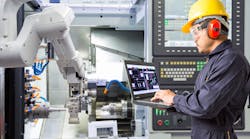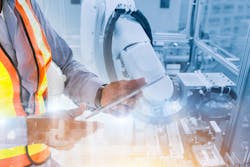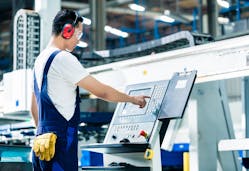Have you ever witnessed a robot malfunction during a trade show demonstration? If so, you will understand the importance of robotic safety equipment. Here, Mark Howard, manager at industrial parts supplier EU Automation, examines the latest advancements in robotic safety and the future of safety on the factory floor.
Traditionally, industrial robots were confined to operate in robotic work cells—reinforced cages that physically separate machines from the workspaces in which humans are present. However, many modern robots are better equipped with safety features which reduce their threat to human workers. In fact, new collaborative models are specifically developed with this in mind.
While physical safety guards are needed to separate humans from traditional robots, this safety precaution lets them operate at full capacity without speed or weight restrictions.
Collaborative Robots
Sometimes referred to as cobots, collaborative robots are marketed based on their ability to work alongside humans. While these robots are still in their early phase—and are therefore significantly slower and less powerful than industrial counterparts—the popularity of these machines demonstrates growing demand for robots that can operate outside of heavy-duty caging.
Cobots are developed based on the technical specifications defined by ISO/TS 15066, the international standard specifically created for collaborative robots. Primarily, this standard requires robots to demonstrate an ability to conduct a monitored safe stop—a pause in operation if a human comes too close to the machine.
Despite this requirement, physical contact between the robot and the worker can take place, providing the machine meets power limitation requirements. According to ISO/TS 15066, the robot must be subject to maximum values and mechanical load limits and prove its ability to limit the maximum permissible forces through drive dimensioning. By implementing these limits, workers should not sustain injury should the robot come into contact with them.
Due to these safety restrictions, collaborative robots are not currently an ideal replacement for all applications. These machines cannot deliver the same power and speeds as their industrial counterparts. So, how can manufacturers achieve greater collaboration on the factory floor, while still enjoying the speed and efficiency of industrial robots?
In applications where a robot is handling sharp tooling, it might be imperative to have guarding or light curtains even if you’ve installed a collaborative robot.
Beyond Basic Standards
Before investing in any new automation, remaining compliant with the latest Occupational Safety and Health Administration (OSHA) and American National Standards Institute (ANSI) codes is the first step. However, manufacturers should be prepared to go beyond basic safety standards to ensure the protection of their workers.
Power presses are a good example of why enhancing safety on the shop floor is so important. These are some of the most unforgiving machines in the factory, with the most common injury cited as amputation, as recorded by the OSHA Safety and Health Information Bulletin.
Meeting regulations is not only essential but can help to minimize the likelihood of these incidents. However, with new automation constantly being deployed on the shop floor, manufacturers should be prepared to increase their investments in machine safety.
With lowering costs and more products on the market light curtains and other non-physical safety barriers are letting industrial robots work closer to workers while maintaining safety.
Advancements in Safety
Machinery will almost always be equipped with its own safety features. However, there are ways to enhance the safety of machinery by integrating new technology. For instance, a power press may be designed to cease operation should it encounter a human body part. However, advanced motion sensors could be installed to ensure the machine stops before contacting the worker.
For particularly dangerous equipment, like power presses, safeguarding the entire perimeter of the machine is advised. For instance, automated safety curtains, which can be locked down during machine operation, will prevent humans from accessing the hazardous area. Using this device, the machine will not activate if the automated safety curtain is in the up position, removing the possibility of humans entering the area.
Similarly, pressure sensitive mat guards and safety light curtains can both be used to detect whether a worker has entered a specific area. Light curtains, for instance, generate a safety stop signal based on movement. Using this method, it is impossible for the machine to operate while a worker is in harm’s way.
While these safety automation methods are advantageous, they do not enable the collaborative environment desired on some manufacturing floors. For this kind of environment to operate successfully, it requires a combination of intelligent safety automation, software and—for the meantime at least—some flexibility on the required power and force from machinery.
Future Factories
Consider this as an example. By collecting real-time data from light curtains and mat guards, a manufacturer could use a programmable logic controller (PLC) to operate as a safety alert device. Monitoring data in real-time, the PLC could automatically raise an alarm based on whether the area has been compromised by a human worker. Automated software could then automatically shut off power to the robots or slow them down for safety, based on the proximity of the worker.
When implemented on a larger scale, this web of sensors and software could enable the smooth running of automated production lines, while protecting the livelihoods of its workers. In fact, with sensors to collect data from all areas of the facility, intelligent software could form a real-time digital simulation of the factory—including the locations and behaviors of all humans working within it.
Currently, manufacturers are required to strike a balance between collaboration and performance. Should they require humans to work directly alongside robots in the factory, manufacturers have to compromise on the power and speeds of the machine. Alternatively, if manufacturers opt for high power, these robots are still confined to heavy duty work cells, often bolstered by other safety automation, such as light curtains and safety mats.
Robots are designed to operate at intense power and meet incredibly high speeds. Therefore, a malfunctioning machine can be potentially life-threatening. Robot safety cannot be taken lightly.




